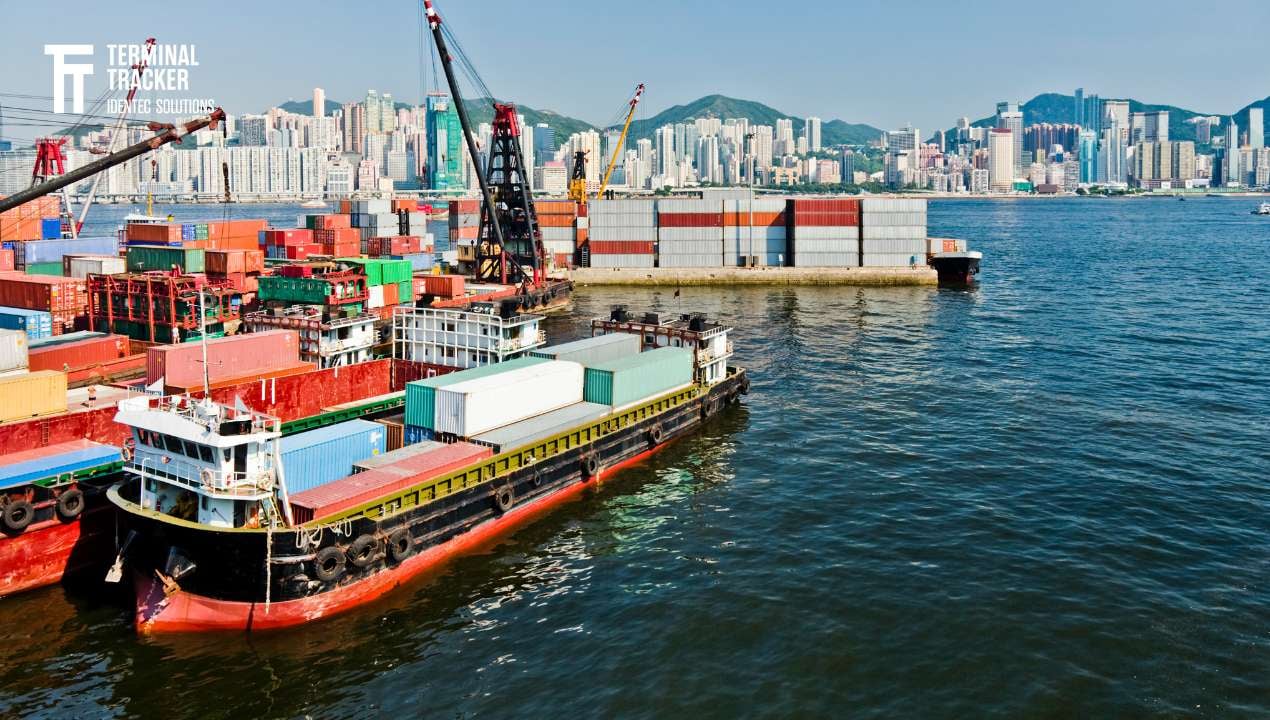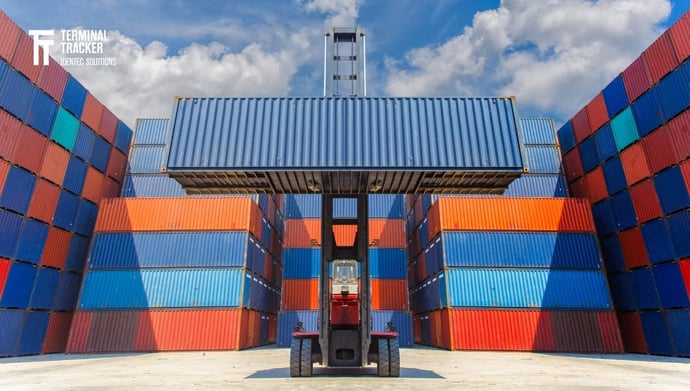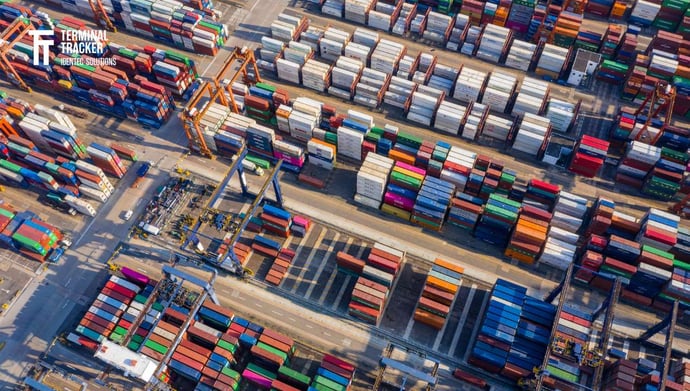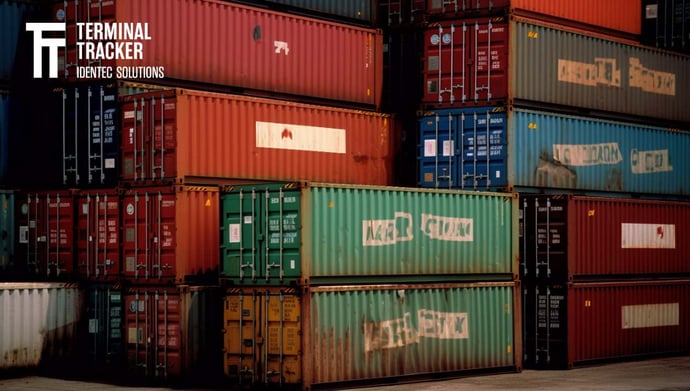Container Handling in the Yard: How to know where your containers are?
| Written by Mark Buzinkay
In this article, we want to discuss how container terminals facilitate complex container handling and how semi-automation is made possible by essential technologies.

No video selected
Select a video type in the sidebar.
"With advanced automation systems, ports can achieve seamless container tracking and management, leading to reduced turnaround times and increased operational efficiency."
Elisa Rouhiainen, VP Sales Marine & Ports
Often seen bustling with cranes, trucks, and vessels, container terminals are akin to the engine rooms of global trade. But they're more than just a point of transfer; these terminals are the nexus of a meticulously coordinated logistical dance, ensuring the smooth and timely transport of goods across the globe.
Every year, a giant amount of cargo (approximately 2.2 billion metric tons of cargo in 2023 (1), packed into 20 or 40-foot standard containers, traverse the oceans. These containers carry anything from raw materials and commodities to finished products ready for store shelves. The responsibility of handling, storing, and ensuring the smooth transition of these containers falls upon the shoulders of the container terminals.
The Art of Container Handling
Container handling is an art perfected over the years by terminal operators worldwide. Overseeing container movements within a terminal entails three key components. The first component relates to maritime operations. The goal here is to minimize ship turnaround times, and the terminal has to adapt to the shipping lines' schedule reliability. The docking area, known as the berth, is designed with specific technical specifications such as length and draft to accommodate vessels.
Container cranes express the interface between the containership and the dock. Cranes have technical specifications regarding the number of moves per hour, maximum weight, and lateral coverage. A modern container crane can have an 18-24 wide range, implying that it can service a container vessel having a width of 18 to 24 containers. A gantry crane can perform about one movement (loading or unloading) every two minutes. The larger the number of cranes assigned to the transhipment process, the faster it can occur. However, effective portside capabilities must be present to adapt this throughput.
Aprons (Loading/unloading areas) are directly adjacent to the docks and under the gantry cranes (portainers). They are the interchange between the cranes and the storage areas where containers are either brought in to be lifted on the containership or unloaded to be immediately picked up and brought to storage areas. This is mainly done with straddlers or holsters. In the case of straddle carriers, the containers are left on the ground, while with holsters, the containers are loaded from or unloaded to a chassis. Using straddle carriers is more common as they enable the movement of containers directly from the dockside to the stack (or vice versa). Still, terminal automation has introduced automated holsters that haul containers from the dockside to stacking areas.
Eventually, container handling includes the safe and efficient loading and unloading of containers from vessels, their movement within the terminal, and their final transfer onto trains, trucks, or other crafts.
Automation has introduced a step change in container handling efficiency. From gantry cranes that can be operated remotely to advanced software systems that track and manage container movement in real time, technology has revolutionized container handling in ways unimaginable just a few decades ago.
Modern container terminals leverage technologies like Terminal Tracker, a game-changing software solution that enhances container handling operations. These systems can monitor container movements in real time, allowing quick workflow adjustments and improved inventory accuracy.
Similarly, integrating cutting-edge AI algorithms and machine learning has helped predictive analytics, allowing operators to foresee and efficiently plan for shifts in demand and potential issues.
Bridging the Gap in Container Handling
Container terminals facilitate cargo movement and bridge the crucial gap between land and sea, local industries, and global markets. That's why they are crucial in the supply chain, ensuring seamless and efficient transport of our daily supplies to where they are most needed.
Even with the rise of technology and automation in Industry 4.0, it's crucial to recognize that non-automated operations that follow traditional methods are still significant. Container terminals that rely on human expertise continue to be crucial players in global trade, showcasing their resilience and precision.
Firstly, it's important to acknowledge that the container handling process is a logistical marvel. Moving millions of TEUs every year is a complex process that demands perfect timing, precision, and teamwork.
In traditional terminals, experienced terminal operators carry out these tasks rather than relying on machines.
The process commences with maritime operations, where human scheduling experts ensure short ship turnaround times by meticulously planning and adjusting the schedule of shipping lines. On the berth, dockworkers execute the precise task of docking vessels according to specific technical requirements.
Container cranes connect the container ship and the dock, a function manned by skilled crane operators. Even in non-automated terminals, modern container cranes can handle a width of 18 to 24 containers and perform a movement every two minutes. While machine learning algorithms may now optimize such tasks, human operators' skill, judgment, and experience remain crucial components in maintaining efficiency.
The loading/unloading areas or aprons represent a crucial interaction point between the cranes and storage areas. Here, terminal workers drive straddle carriers or holsters to move containers. These vehicles transport containers from the dockside to the stack or vice versa, a task that requires acute spatial awareness and safety consciousness.
In this complex process, humans must react swiftly to unexpected issues and make rapid decisions, something which even the most advanced AI can struggle with. As such, the human element in non-automated terminals offers a unique form of flexibility and resilience.
It is important to understand that technology does not threaten traditional terminal operators, but it can be a useful tool that aids in their work. From telematics systems that track vehicle movements to software like Terminal Tracker that monitors container locations, technology can enhance traditional operations and aid human decision-making.

What is Automated Container Handling?
One area where Industry 4.0 is transforming the global economy is particularly evident at container terminals, where a shift towards full automation significantly redefines operations. A primary advantage of automation in container terminals is efficiency.
A fully automated terminal employing technologies such as automated guided vehicles (AGVs) not only dramatically reduces the need for manual labour but also streamlines operations, resulting in shorter ship turnaround times and faster container movement within the terminal.
Automated terminals also benefit from reduced human error, leading to increased safety. Autonomous machines can perform tasks more precisely and consistently than their human counterparts, decreasing the risk of accidents and cargo damage. Moreover, automated systems can operate around the clock without fatigue, enhancing terminal productivity and increasing throughput and potential cost savings over time.
Central to the operation of fully automated terminals is the sophisticated technology powering them. Terminal operating systems act as the nerve centre of operations, providing real-time scheduling and management of all container movements; furthermore, they can anticipate potential issues and accurately predict future demand by incorporating AI and machine learning. This predictive capacity has revolutionized terminal operations, empowering operators to make proactive decisions that boost productivity and optimize efficiency.
While automation reduces the need for human labour, skilled personnel are still required for strategic planning and system maintenance. Sometimes they have to address the rare instances when manual intervention is necessary. Hence, while automated terminals signify a significant shift in operations, they do not mean the end for human involvement.
How Can Container Terminals be Semi-Automated?
Container terminals sit at the crossroads of global trade, acting as the vital junction between the sea and land. As these bustling hubs of activity grapple with the increasing complexity and volume of cargo, efficiency and accuracy are more paramount than ever. This is where Terminal Tracker comes in, a transformative solution for semi-automated container terminals, ensuring seamless operations through its Container Handover and Container Inventory modules.
In the intricate ballet of container movement, precise tracking is vital. Terminal Tracker's Container Handover module has been designed to improve the accuracy of yard inventory by removing assumptions about container positions during movement. This clever integration with positioning and vehicle identification technologies facilitates a seamless link of container events from one handler to another (also learn about the Container Control and Container Weight modules of Terminal Tracker).
The process, in essence, involves the Terminal Tracker On-Board Controller (OBC) monitoring the height of the container spreader and any changes in the twist lock pins. An event is generated when the pins latch onto a container, and the spreader reaches the correct height. This event, including the container's location calculated using an IR beacon from the internal truck, is sent to the Terminal Tracker server, which pushes it to the Terminal Operating System (TOS) interface.
The result is improved reporting task accuracy, performance metrics, and real-time map experiences. Any tracking errors can be promptly corrected, ensuring each container is meticulously tracked to its new location.
Adding another layer to its functionality, Terminal Tracker's Container Inventory module focuses on enhancing yard inventory efficiency and accuracy. It operates by linking container lift and drop events to a specific slot location, which is identified using advanced position detection technology.
Imagine a typical scenario: A vehicle operator lifts or drops a container. This immediately prompts the module to send the vehicle's designation, the stage of the move (either lift or drop), and the slot location of the container to the TOS. The vehicle is returned to an idle state or placed back on the job list in real-time, boosting operational efficiency. As the module can handle exceptions, catering to unique operational behaviours makes it a practical solution for various operating environments.
In essence, Terminal Tracker fundamentally redefines how semi-automated container terminals operate. With its innovative Container Handover and Container Inventory modules, it is enhancing accuracy, boosting efficiency, and paving the way for a new era of optimized container handling.
As we continue to witness the evolution of global trade, solutions like Terminal Tracker are adapting to these changes and shaping the future of container terminals.
FAQ
Why is Human Intervention Still Crucial in Automated Container Terminals?
Even in fully automated container terminals, human intervention is essential to ensure smooth operations and resolve unexpected problems.
One important area is system maintenance and troubleshooting; automated systems cannot (yet) maintain themselves and resolve errors, nor can they carry out software and system updates themselves. The same applies to the maintenance and repair of automated equipment such as cranes and automated guided vehicles (AGVs). But, humans must also intervene in the event of technical problems with the software and hardware; automated systems cannot handle these themselves.
Unforeseen circumstances and exceptional situations still require human intervention due to their complexity. In emergencies such as accidents, equipment failures or natural disasters, immediate human decision-making is crucial. In addition, human assessment and operational management are indispensable in severe weather that can affect the performance and safety of automated equipment.
Other areas include monitoring and quality control of systems to ensure they work as intended and adjustments can be made where necessary. Monitoring safety and quality standards in container handling also still requires humans.
Strategic planning and decision-making are inherently human tasks, especially when dealing with complex logistical challenges. Human judgment and expertise are essential here, and the same is still true for customs procedures. Legal compliance and documentation often require human interpretation and interaction with authorities.
It is not always possible to follow the rules strictly; some discretion remains. In certain situations, human operators may need to manually override automated systems to ensure safety, security or operational efficiency.
Finally, of course, contingency planning, including setting up and managing backup operations in the event of system failures, is also largely dependent on humans.
Takeaways
As we look at the future of semi-automated container terminals, several key insights emerge from Terminal Tracker's groundbreaking technology:
Enhanced Accuracy: The Container Handover module eradicates errors in container tracking, ensuring precise monitoring of each container's position during movement. This accuracy is pivotal to managing the vast and complex logistics involved in container terminal operations.
Boosted Efficiency: The Container Inventory module focuses on improving the efficiency of yard inventory by enabling a swift return of vehicles to an idle state or a job list, post a lift or drop event. This real-time relay of information enhances overall operational efficiency, a critical aspect in fast-paced container handling operations.
Terminal Tracker performs in adaptability and flexibility, as it can accommodate a diverse range of vehicles and unique operational behaviours. Its ability to adjust to various operational needs and handle exceptions showcases its versatile design and future-proofing approach.
Shaping the Future: Terminal Tracker's transformative technology influences the future of semi-automated container terminals by enhancing accuracy and efficiency in container handling.
In conclusion, Terminal Tracker embodies the symbiosis of technology and logistics, playing a pivotal role in revolutionizing semi-automated container terminals (read more about Smart Port Technology). Semi-automation is promising a more efficient, accurate, and robust future for container terminals worldwide.
Dive deeper into one of our core topics: Smart Port
Glossary
Lateral coverage in container cranes refers to the horizontal reach or span of the crane, determining how far it can extend to load or unload containers across a ship’s width or within a terminal yard. This coverage is critical for handling large vessels efficiently and ensuring that all container rows are accessible. Modern cranes often have lateral coverage ranging from 18 to 24 container rows. (2)
Standard containers, also known as general-purpose containers, are durable metal boxes designed for intermodal freight transport. They conform to ISO standards and are typically 8 feet wide, 8.6 feet high, and 20 or 40 feet long. These containers are closed on all sides, weather-resistant, and used for transporting dry goods like electronics, clothing, or furniture. Their standardized design facilitates seamless transfer across ships, trains, and trucks in global logistics. (3)
Sources:
(1) https://www.contimod.com/container-shipping-statistics
(2) Cranes and Derricks by Howard I. Shapiro and Jay P. Shapiro, McGraw-Hill Education, 2010
(3) The Box: How the Shipping Container Made the World Smaller and the World Economy Bigger by Marc Levinson, Princeton University Press, 2006
Note: This article was updated on the 7th of March 2025

Author
Mark Buzinkay, Head of Marketing
Mark Buzinkay holds a PhD in Virtual Anthropology, a Master in Business Administration (Telecommunications Mgmt), a Master of Science in Information Management and a Master of Arts in History, Sociology and Philosophy. Mark spent most of his professional career developing and creating business ideas - from a marketing, organisational and process point of view. He is fascinated by the digital transformation of industries, especially manufacturing and logistics. Mark writes mainly about Industry 4.0, maritime logistics, process and change management, innovations onshore and offshore, and the digital transformation in general.
Related Articles
Related Product





